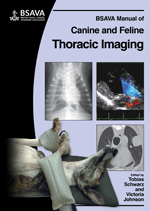
Full text loading...

Please note. The new 2nd edition of the BSAVA Manual of Canine and Feline Thoracic Imaging is now available here.
Thoracic radiography is an essential tool in the investigation of both thoracic and systemic disease. […] Despite the fact that radiography is easy to perform, careful technique is required to ensure that high-quality films are obtained. Poor technique is a common reason for misdiagnosis. The first part of this chapter outlines the methods that should be used to obtain thoracic films and special techniques to enhance their diagnostic yield. […] The second part of this chapter introduces some of the basic principles of thoracic radiology that apply to all anatomical regions. The following topics are discussed: Restraint and patient preparation; Technique; Digital radiography; Contrast radiography; Fluoroscopy; Systemic evaluation of the thoracic radiograph; Variations in radiographic anatomy; Essential principles of interpretation.
Basics of thoracic radiography and radiology, Page 1 of 1
< Previous page | Next page > /docserver/preview/fulltext/10.22233/9781910443088/9781910443088.1-1.gif

Full text loading...























